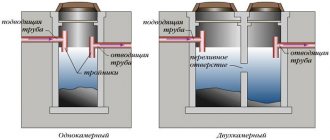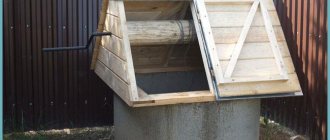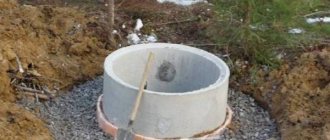Home |Construction |How to make a cellar from well rings correctly?
Date: December 9, 2018
Comments: 0
There is not always a ready-made cellar at a summer cottage. Sometimes the size of the existing premises makes it difficult to accommodate all the preserved and grown crops. Summer residents are wondering if it is possible to make a reliable cellar on their own from concrete rings - simple, accessible, inexpensive building elements? Any summer resident or owner of a private building who has not previously been involved in construction can cope with this task. It is important to have the desire and one or two well rings, the diameter of which is 2 m.
Using a cellar allows you to ensure the safety of the crop regardless of temperature and time of year. Let us consider in detail the positive features of the concrete structure and the technology for performing construction work.
Owners of summer cottages or private houses faced the problem of storing crops
Peculiarities
A cellar made of ring reinforced concrete elements has a number of undeniable advantages, among which the following points stand out:
- Simplicity of design, the manufacture of which can be carried out by a summer resident who is not familiar with the specifics of construction work.
- Ease of use, thanks to which it is possible to quickly remove and replenish reserves.
- Maintainability, allowing, if necessary, to restore part of the structure using concrete mortar.
- The absence of the negative impact of elevated temperature and direct sunlight on food products, which ensures the necessary shelf life of the preservation and the safety of agricultural products.
- Low costs for construction work, which are affordable to the majority of summer residents with average incomes.
The only drawback of this design is the significant mass of the rings, which require a special lift to immerse.
Pros and cons of construction
If we talk about the advantages, we will highlight:
- Easy to install. To do this, you don’t need to be a builder and study the requirements.
- Possibility of increasing the cellar. If at any point you decide that the structure could be deeper, you won’t have to dismantle it. Sections can be added to an existing structure.
- Ease of use. Essentially, this is a reinforced pit with a ladder into which supplies are stored.
- Resistant to sunlight and temperature changes. In addition, reinforced concrete is resistant to aggressive environments and chemicals.
- Durability of the material (rings do not collapse for 20-30 years). Reinforced concrete is the most affordable option. The cellar will not require repairs for a long time.
It is worth noting the negative aspects of reinforced concrete structures. First of all, these rings are very heavy. They simply cannot be delivered and installed in the right place. This means you will have to pay for the services of lifting equipment or come up with a mechanism based on a winch.
The second disadvantage is the lack of variety of forms. This means that if you are a designer at heart, then you won’t go anywhere with faceless round shapes. On the other hand, if we are talking about an underground cellar of the simplest type, then the interior decoration should not be particularly concerning.
But no matter how simple this design is, it has its own characteristics that are worth paying attention to
Design differences
You can get a fairly spacious cellar if you use rings with a diameter of 2 m. The use of this size will allow you to create a comfortable room that can accommodate the entire grown crop and a significant amount of preservation.
If you want to build a small structure for storing food, then the best option is a concrete cellar
The use of concrete rings as structural elements requires knowledge of their distinctive features. Externally, the different types of products do not differ from each other, with the exception of sizes. However, there are certain nuances that affect the method of fixing structural elements, which are visible only to specialists. Let's look at them in more detail:
- products with protrusions at the upper end part. A concrete collar at one end allows it to be joined with a similar recess at the bottom. This ensures a reliable locking connection. When installing a group of products vertically, a powerful concrete lock around the perimeter prevents the possibility of displacement even with significant soil movements;
- Products of the standard type with a flat end, when installed on top of each other, are fixed using steel brackets and concrete mortar. The stability of the structure during ground movement is associated with the strength of the metal fastening and the correct implementation of waterproofing.
Having decided to build a cellar from rings, it does not matter which design option to use, since it is unlikely that significant soil displacements are possible at the depth of the room.
Creating ventilation
In order for winter supplies to be well preserved, ventilation should be properly organized. If the air actively moves through the cellar, the humidity will remain at the optimal level. There are 2 ways to perform ventilation:
- with 1 pipe – this type of ventilation is supply and exhaust;
- with 2 pipes - an air supply and exhaust system of this type is equipped in medium and large rooms.
For effective ventilation operation, 2 pipes should be installed. One will be a supply, the other will be an exhaust. They must be placed in opposite corners of the cellar. The supply pipe is mounted 40 cm from the floor of the room. It is brought up to the roof level. The exhaust pipe should be installed near the ceiling. She is taken straight up.
On what principle does this ventilation work? Due to the temperature difference, as well as the force of the wind, stale air is drawn out, and fresh air enters the room. This creates natural draft in the ventilation system.
A pressure difference also forms over the roof. This is due to the fact that the exhaust pipe is raised above the roof. The air that is removed from the cellar is replaced by fresh air. This process occurs almost constantly.
To protect the supply ventilation pipe from rodents and debris, cover it with a metal mesh. When building a small cellar, you can install only 1 pipe in it. In this case, the air will either be drawn out or flow into the room.
As you can see, building a cellar using concrete rings is quite simple. However, it is worth taking into account the characteristics of the soil and operating conditions of the room.
Advantages of structural elements
Concrete rings have a number of positive characteristics that allow them to be confidently used as elements used for the construction of a storage facility.
For the cellar it is better to choose rings with a large diameter
The main advantages are:
- A significant level of strength that allows it to withstand soil pressure, prevent seasonal soil movements, and counteract closely located aquifers.
- Long service life exceeding 2-3 decades, which is quite enough for an inexpensive and prefabricated country house building.
- Resistance to significant temperature fluctuations, allowing products to withstand a virtually unlimited number of freezing and thawing cycles. Having done waterproofing well, do not worry about the safety of agricultural products and preservation, no matter to what level the soil freezes and how deep the cellar is.
- Resistance to aggressive environments and chemically active liquids, allowing to prevent the penetration of pesticides used in the treatment of garden plants and protecting them from pests. Carried away by rainwater after spraying and fertilizing the soil, the chemicals will not be able to enter the room, which provides reliable isolation of the products.
A set of positive aspects allows summer residents to confidently choose concrete well rings, which have proven themselves to be a reliable product for building storage.
Advantages of the structure
| Options | Characteristic |
| Simplicity | No need to pour a foundation |
| No need to reinforce walls | |
| Construction requires no skills | |
| Durability | Service life - more than 20 years |
| Strength | Resistance to groundwater |
| Resistance to seasonal soil movement | |
| The walls can withstand soil pressure | |
| Cold resistance | Placed at any depth |
| Good waterproofing will not allow the cold to “get” into the structure | |
| Chemical resistance | Proper insulation protects against exposure to toxins |
| Space saving | The cylindrical shape allows you to save space with sufficient internal volume of the room |
Disadvantages of products
Like any structural element, well rings, along with their positive aspects, have a number of disadvantages.
For concrete cellars, one concrete ring may be enough to store crops
These include:
- significant weight of products, exceeding a ton for certain designs, which creates a number of serious problems associated with transportation and installation, and also causes additional costs;
- the likelihood of cracks arising due to the fragility of products under significant targeted forces;
- the need for thermal insulation and installation of waterproofing protection.
Despite a number of these disadvantages, concrete structures in real conditions have confirmed the possibility of being used as a frame for a convenient and reliable prefabricated storage facility.
Waterproofing
To ensure the longevity of the cellar, protection from moisture is provided, since concrete is susceptible to corrosive processes. The following is used as protection:
- Internal waterproofing. After installing the rings, a cement-sand mortar is applied along the joints, which prevents water from entering the storage facility.
- External waterproofing. They use roll, film and liquid moisture protection products. These products are used to treat the outer side of the rings, protecting the concrete from the destructive effects of water.
Preparatory stage
When planning upcoming work, pay special attention to the following important points:
- The dimensions of a storage facility based on reinforced concrete products must ensure the possibility of storing crops grown on a specific plot of land and canned goods made from them.
- Choose a convenient location on the site that allows you to comfortably operate the structure.
- Give preference to a location on a hill that protects the room from the penetration of melt water and precipitation.
- Determine the level of aquifers that affect the penetration of moisture into the structure.
- For nearby groundwater, install a drainage system.
First you need to dig a hole the same diameter as the concrete rings
Reinforced concrete square rings for the cellar Novosibirsk. Concrete squares price (square rings)
The cost of a square concrete ring is 6500 Rubles |
|
Types of storage
Using standard purchased concrete products, you can build a room in various options:
- In the form of a horizontally located group of well rings, which together form a not deeply buried above-ground cellar. This option is used for aquifers located close to the surface.
- Vertical type, with one or more well rings immersed in a cylindrical pit corresponding in size to the diameter of the products.
Each option has its own characteristics. Let's look at them in more detail.
Production of reinforced concrete structures
Reinforced concrete products are used to construct wells of various types: gas, inspection, sewer and water supply. Rigid concrete is used to make rings. There are several known technologies for the production of reinforced concrete rings for wells:
- Volumetric vibrocompression. The creation of the structure is carried out by volumetric vibrocompression of concrete products. Processing takes place in special metal forms that have the function of immediate removal of formwork. The use of a brick press increases the speed of manufacturing rings for wells. Vibrocompression significantly saves space for performing the necessary processes. The use of such an installation reduces the need for a large number of maintenance personnel. For high-quality production you will need only 2-3 people.
- Molding creation. Outdated production technology. In this case, the birth of reinforced concrete structures is carried out using metal formwork. A special form, called metal-plastic, has two cylindrical surfaces: an outer and an inner part. A concrete mixture is laid between them. When the concrete has hardened thoroughly, the metal formwork is removed. The use of injection molding technology is only possible if there are large premises, since space will be needed not only for creating products, but also for their drying and subsequent storage. Production volumes depend on the number of metal molds.
https://youtube.com/watch?v=NPLgo_RSpXw
Types of products
The round reinforced concrete structure serves as a reliable assistant during the installation of utilities. Rings are conventionally divided into several main types:
- water intake;
- collectors;
- rings intended for installation of underground cable electrical networks;
- sewer and gas pipeline concrete structures.
Also on the modern market you can find the following products:
- Overlapping rings.
- Device with a lock or with a bottom.
- Auxiliary. Made to order. With non-standard sizes. They are used in emergency situations when conventional rings are not suitable for forming a well depth shaft.
- Wall. Suitable for constructing any type of well. They participate in the formation of the neck of the created structure.
- Reinforced concrete. Actively used during installation of system communications. They will be useful during the construction of a water supply, network, gas, drainage or sewer well.
Concrete structures with different parameters are available in modern construction stores. The standard, maximum dimensions of this product are as follows: height - 100 cm, internal diameter is about 200 cm. Specific weight no more than 300 kg. The maximum wall thickness is 120 mm.
Advantages and disadvantages
Ready-made structures, like any existing building material, have their pros and cons. The strengths and weaknesses of reinforced concrete rings should be noted. Each of the advantages improves the performance of the well. Reinforced concrete products have the following positive qualities:
- Rigidity. Thanks to its rigidity, the ring can be used even on unstable ground.
- Availability of a rich and wide range of sizes.
- Concrete adapts well to any environment, so structures have a long service life. Products can perform their functions without interruption for 100 years.
- They speed up and facilitate the process of installing a sewer or water supply system.
- High quality and reasonable price.
- High level of tightness. The seams fit tightly together. This eliminates the possibility of groundwater getting inside the product.
However, reinforced concrete products have their drawbacks. So, the main disadvantages of these small structures are:
- Lack of mobility. It is almost impossible to move the created water supply structure.
- The weight and dimensions of the product are also considered a disadvantage. To install reinforced concrete devices you will need special equipment. Its use requires additional material costs.
Non-recessed option
Having given preference to a horizontal structure, carry out construction work in the following sequence:
- dig a hole in the soil, going a minimum of 0.5 m from the zero mark;
- carefully compact the soil in an area exceeding the dimensions of the future structure by 0.3-0.4 m on each side;
- pour three layers, 5 centimeters each, of crushed stone, compact each tier step by step;
- fill the base with a layer of sand up to 10 centimeters, compact the surface;
- lay down a plastic film that performs a waterproofing function;
- install wooden formwork;
Before making a cellar correctly, you need to familiarize yourself with the basic rules of its construction.
- install a frame made of steel reinforcement with a diameter of 12 mm and a side size of a square cell of 20 cm;
- fill the base cushion with concrete mortar 10 centimeters thick;
- using a template made of wood or metal, form a landing area on the hardening concrete that corresponds in radius to the shape of the element;
- allow the concrete to harden;
- roll the elements onto the support;
- lay the back element with brickwork, installing a brick one and a half thick. Use a product with a bottom as the last element;
- install an exhaust pipe during the laying process;
- connect the structural elements with steel brackets;
- seal the joints using cement mortar;
- fill the storage with soil;
- create an entrance by installing doors and filling the remaining gaps with brick or rubble stone;
- insulate the outer wall from the inside.
These are the simple stages of work on the construction of a horizontal-type structure from well elements.
Selection and installation of rings
For the construction of a cellar, concrete rings with a locking connection are best suited. As a lower element, you can use a concrete ring with a bottom; this will save you from the need to create a floor, but it cannot be installed in the second way. Keep in mind that the most popular ring for cellar construction, KS 20.9, weighs almost one and a half tons, and its height is about a meter, so even just moving this product will require the strength of a dozen people. Therefore, in order to build a cellar from 2m concrete rings with your own hands, you need a crane with sufficient lifting capacity. You can make it yourself, buy it or rent it, and we recommend the latter option. In addition to round ones, you can also use concrete square rings for the cellar, because they differ only in shape, and the preparatory measures and installation are the same.
Before starting work, you need to choose the diameter and size of the rings. The larger the diameter, the more convenient the cellar will be, but the more difficult its construction will be, the same applies to the height of the rings. Then you need to determine the height (length) and the number of concrete rings required to create it. If you do not have the desire or ability to make a large-diameter cellar, you can use a caisson structure, that is, a shaft without steps and a retractable round rack, the outer diameter of which is slightly smaller than the inner diameter of the well. However, to do this, you will have to install an insulated shed above the cellar, in which a lifting mechanism will be located, consisting of a manual or electric winch and a sufficient length of rope or chain.
Before installing the rings in place, treat them on the outside and inside with bitumen, tar or other protection against water. You can use a mixture of cement, water and liquid glass. After this, the concrete rings are put in place, coating the joints with cement mortar with the addition of liquid glass. The excess solution will be squeezed out by the weight of the ring above, so it will need to be removed immediately.
If you are making a horizontal cellar, then you first need to thoroughly compact the soil and lay crushed stone and sand cushions, each 5–10 cm thick, on it. Then the concrete rings are treated with waterproofing and laid in place, coating the joints with cement mortar with the addition of liquid glass.
Construction of a vertical cellar
Carrying out activities for the construction of a vertical storage facility is not particularly difficult. This process is much simpler than arranging standard cellars, where there is a need to strengthen the ceiling, build walls, and create complex waterproofing. The entire range of work can be completed by one person, however, if you have assistants, you will get the job done much faster.
The inside of the cellar can be equipped at the owner's discretion
To ensure the storage of a small crop, you can install one well ring. The use of two or more elements will significantly increase the spaciousness of the room. It is not difficult to purchase products used for wells, sewer systems, and septic tanks, as they are widely offered in specialized stores.
When performing work, follow the following sequence of steps:
- Dig a cavity of the required size in the ground, focusing on the diameter of the element and its height. The size of the pit should make it possible to lower the concrete ring without applying significant loads with a gap.
- Pour the sand-crushed stone mixture into the hole, compact it thoroughly, forming a base.
- Fill the surface with a concrete solution or make a screed based on a cement-sand composition.
- Using a special lift, lower the concrete rings to the bottom of the hole. When performing work, be careful, as there is a possibility that the products may crack if handled carelessly.
You can try to lower the elements without the help of lifting devices, digging them around the perimeter. As a result, they will gradually descend.
DIY basement floor
When the room is already covered, you can begin interior decoration. The floor in a storage facility is not only a base, but also a waterproofing barrier, so its design is selected based on ground conditions.
If the soil is dry and dense, you can get by with crushed stone-sand backfill or a simple earthen floor. In other cases, the following are used for coating:
- concrete;
- stone;
- brick;
- tree;
- clay.
In the cellar where food supplies are stored, the floors should not only be smooth and durable, but also safe, easy to clean, and hygienic.
Zemlyanoy
This is the simplest option, which does not require any material costs. The ground is leveled, hummocks are cut off, the surface is covered with crushed stone, gravel, and sand.
Despite the availability of earthen floors, they are not the most practical; they will not be able to protect against possible leaks during seasonal rains or melting snow. They can only be used at higher elevations on dry, non-moisture-intensive soils.
Concrete
Such floors are strong and durable, easy to care for and disinfect. The concrete base consists of several layers:
- compacted crushed stone-sand cushion 50-100 mm thick;
- filling with bitumen or double layer of roofing material;
- reinforcing mesh;
concrete 50-100 mm thick; finishing coating.
Concrete floors can be insulated with polystyrene foam or expanded polystyrene, which are not afraid of moisture and do not rot. Thermal insulation is laid directly on the crushed stone-sand cushion on the ground, and concrete is poured on top. This base does not freeze and protects the room well from soil moisture.
Brick or stone
The material for the cellar floor should not be afraid of contact with the ground. Clay bricks meet this condition; silicate bricks become moldy and quickly collapse. In addition to being resistant to moisture, red brick has low thermal conductivity and protects floors from freezing. In areas where natural stone is mined, it is rational to use this available material.
The procedure for installing brick floors:
- Filling with sand and gravel mixture, compaction.
- Filling with bitumen or liquid clay.
- Laying double roll waterproofing.
- Brick or stone masonry with cement-sand or clay mortar with filling of joints or dry.
Such floors are very strong and durable and do not require decorative finishing.
Wood
Wooden floors can be used on dry soils. Timbers treated to prevent rot are laid on a base of crushed stone or pebbles, and boards with a thickness of at least 40 mm are attached to them.
For strong fixation, each connection must have at least 2 nails or screws. It is better to use galvanized fasteners.
Clay
The traditional material for waterproofing is fatty clay. When soaked it is elastic, and when hardened it is very durable. To reduce cracking, sand is added to the clay solution.
The base of the floor is a mixture of crushed stone with bitumen or liquid clay 100-150 mm thick. Rolled waterproofing is laid on top with an overlap onto the basement walls. Now you can pour the clay in its pure form or by mixing it with crushed stone. After hardening, the cracks are filled with mortar.
Sealing
When building a cellar, take protective waterproofing seriously. Use special compounds that should cover the entire concrete surface, which will hinder the penetration of groundwater.
Since such a cellar has connecting seams, you cannot get by with a simple method of waterproofing; you will need special waterproofing
Perform processing from the inside and outside using:
- on the outside - roofing felt, liquid glass;
- from the inside - special mastic.
After completing the insulation measures, fill the cracks with concrete. Fill the gap around the perimeter of the structure with soil and then compact it. Now start arranging the internal volume.
Step-by-step instructions on how to fill a cellar ceiling with concrete. Carrying out concreting
Now let's figure out how to fill the ceiling in the cellar. After all, now we need to prepare the formwork correctly and fill it with concrete. This must be done as quickly as possible.
To do this, start preparing a cement mortar that will have binding properties and have fillers - sand and crushed stone. This can be done either using a concrete mixer or manually. How to cover a cellar ceiling is now in detail.
Attention. It is best to use concrete with a grade of at least 200. This will significantly strengthen the structure and extend its service life.
So:
- Fill the formwork in several passes, but in one direction. When pouring the mixture, do not forget to compact it so that there are no voids inside.
- It is important to ensure the strength of the ceiling slab. Check for unevenness using a building level.
- Make sure that the solution is not exposed to direct rays of the sun, wind or drafts. Carefully ensure that the poured slab is not subject to various mechanical influences.
- Water the stove with plain water for a week to ensure it cools evenly. You can then work with the slab after 21 days, at which time you will remove the formwork itself.
- The quality of concrete floors will depend on the materials chosen. Choose cement M-250 or M-400 (with the addition of special heavy fillers).
- Before starting work, calculate the size of the room and the required amount of building materials. This way you can save money.
When you make a concrete floor yourself, you think through and install all the necessary communications yourself. When the flooring is laid on top of the slabs, level the surface with a self-leveling mixture.
You can equip the hatch to the basement with a secret handle that will not interfere with walking.
Interior improvement
The space inside the storage can be arranged taking into account the wishes of the owner. It is important to rationally use the volume and place comfortable radius-shaped shelves around the perimeter.
The minimum volume will be occupied by a ladder of an attached structure, removable or fixed to the surface. The main thing is to ensure safe access conditions to the storage facility.
Seal the top cover as thoroughly as possible. Use thermal insulation materials to finish it, install a water barrier. Use durable wood covered with roofing felt sheets. This will ensure a comfortable temperature in the room and prevent the penetration of cold air.
The presence of a special pipe that provides air flow will provide good ventilation and allow you to store agricultural products and preserves all year round. In a well-ventilated room equipped with fresh air ventilation, there will be no problems with condensation on the surface of the lid. Reliable protection from precipitation will be provided by a gable roof located above the cellar.
Ventilation
For good preservation of supplies, you need to do proper air exchange. If there is sufficient air circulation, then optimal humidity is maintained. There are 2 ways to make ventilation - with one pipe or with supply and exhaust pipes.
The connection to the roof is made one meter above the surface. To protect pipes from leaves and debris, put a mesh on them, put on an umbrella or mount a deflector.
This type of ventilation works due to the difference in temperature and pressure. In autumn and winter, it is much warmer inside than outside.
Warm air rises to the top, and fresh air from outside enters in its place. You need to put a valve inside that will regulate the clearance. If the cellars are small, then you can get by with one pipe, then the air flows in and out.
Relevance of storage facility construction
A ring cellar is a proven choice for owners of private houses and cottages if it is impossible to build or use a cellar built into the building. It is intended for the following categories of owners:
- Residents and summer residents permanently living in a private house who do not have built-in storage space. The design of the existing premises does not always allow for the construction of a reliable storage facility, taking into account building codes that require compliance with the necessary waterproofing and thermal protection.
- Owners of small summer cottages who grow crops with their own hands and do not need a spacious stationary cellar. Following the recommendations for organizing storage will allow you to ensure an optimal temperature of 4-5 degrees Celsius all year round.
Prefabricated concrete storage is a serious alternative to permanent premises located in the building.
Materials
The choice of material for the cellar also depends on the groundwater level. In a dry place, you can build from whatever you want - any material suitable for these purposes: impregnated wood, brick, concrete, building blocks.
You can make a concrete cellar on any soil
If the water is close to the surface, it is necessary that the material is not afraid of moisture, has low hygroscopicity (preferably close to zero) or has the ability to significantly reduce it. But, in general, only concrete and metal meet these requirements. Concrete is preferable - it is definitely not afraid of getting wet, it does not absorb water very much, although it can conduct it through capillaries. The good thing about concrete is that there are various ways to make it virtually impermeable to water in any form:
- Additives are additives that give concrete certain properties. There are also additives that make it practically non-conductive and non-absorbent of water.
- Hygroscopicity can be reduced by vibrating the concrete during laying (there are special vibrators for concrete). Due to the compaction of the structure, its density becomes significantly higher, and its hygroscopicity decreases.
- Treatment with deep penetration impregnations. For concrete, cement-based compositions containing polymers are used. Polymers block capillaries through which water leaks. Double treatment allows you to reduce the amount of moisture seeping through the concrete by 6-8 times.
- Rubber paint. It is used for swimming pools, but in extreme cases it can help prevent moisture from entering the cellar.
All of these products in combination, or one or two to choose from, will help keep the cellar dry even in areas with high groundwater levels.
You can also build a cellar on high groundwater from metal. A sealed box of the required size is prepared, and spacers are welded to the bottom and walls. This metal box is treated on the outside with an anti-corrosion compound (several times) and buried in the ground. If the seams are made well, water will not leak out, but there is another problem - if there is a large amount of water, this box can be pushed to the surface. To prevent this from happening, spacers are welded, but they only help up to a certain pressure created by the water. It may well happen that such a cellar will “pop up”.
A metal cellar will not leak, but it may “float”
When building a cellar with a high groundwater level, ceramic bricks are still acceptable. But over time, it crumbles from water, although it is possible to significantly reduce its hygroscopicity - treat it several times with the same deep penetration impregnation. And yet, brick in high water is only a last resort.
Made of metal
Metal products are considered more durable and reliable than those made of wood. However, building such a structure is much more difficult.
To make it you will need the following tools:
- Grinder with a metal disc;
- Welding equipment;
- Drill with attachments;
- Measuring tape;
- Construction knife.
You will also need the following materials:
- Steel sheet with a thickness of 3 and 1 mm;
- Metal corner;
- Fastening loops;
- Shock absorber;
- Anchors;
- Thermal insulation material;
- Rubber gaskets;
- Primer mixture.
To make a cover for the entrance opening, it is necessary to cut a sheet of steel material of the required dimensions.
Then a corner is welded along the entire perimeter from the inside. Also, a metal corner is used to create stiffening ribs on the surface of a steel sheet, thereby dividing the structure into four sections.
Insulation with a width no larger than the corner is laid into the resulting voids.
Then a sheet of steel 1 mm thick is laid over the thermal insulation overlapping and bent using a wooden hammer. Afterwards, the coating is fixed to the corners with metal screws.
The next step is to install the basement entry frame. To make this element, you will need to cut the corner into pieces according to the required dimensions.
Afterwards, the resulting fragments are welded and fixed to the concrete surface with anchors. One side of the base serves as a support for the metal lid.
A rubber gasket is attached to the protruding part of the frame, which prevents heat loss and protects the coating from damage and friction.
A shock absorber is also installed for easy opening. The handle for opening the door is welded to the top covering.
After completing the fastening work, all metal parts are coated with drying oil to prevent corrosion.
Video on the topic:
Having become familiar with the installation features and types of manufactured structures, it will not be difficult to figure out how to make a cellar hatch with your own hands.











